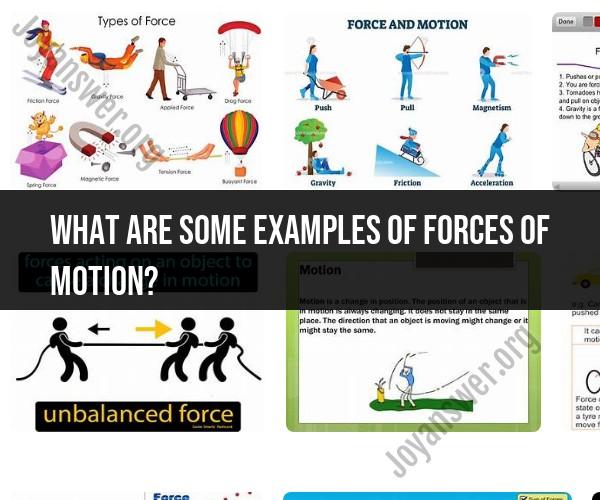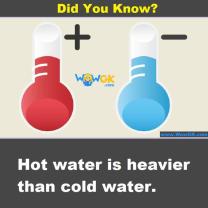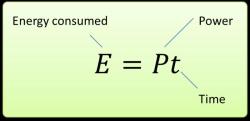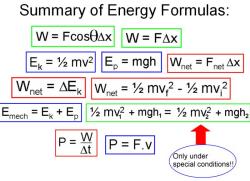What are some examples of forces of motion?
Forces in motion are prevalent in our daily lives, and they play a fundamental role in the behavior of objects. Here are some real-life scenarios and examples of forces in motion:
Gravity:
- When you drop a ball, it falls to the ground due to the force of gravity. Gravity is what keeps us anchored to the Earth.
Friction:
- When you walk on a rough surface, the friction between your shoes and the ground allows you to move forward without slipping.
Applied Force:
- Pushing a car to get it moving is an example of applying a force to overcome inertia and initiate motion.
Tension:
- When you swing on a swing set, the tension in the chains or ropes supports your weight and keeps you swinging.
Normal Force:
- When you sit on a chair, the chair exerts an upward normal force to counteract the downward force of gravity, allowing you to remain seated.
Air Resistance (Drag):
- Riding a bicycle at high speed exposes you to air resistance, which opposes your forward motion and requires you to pedal harder.
Buoyant Force:
- When you float in a swimming pool, the buoyant force exerted by the water supports your body, allowing you to stay afloat.
Electromagnetic Forces:
- Magnets attract or repel each other due to electromagnetic forces. For example, like poles of magnets repel each other, while opposite poles attract.
Torsional Force (Torque):
- Turning a wrench to loosen or tighten a bolt involves applying torque, which is a twisting force.
Spring Force:
- Compressing or stretching a spring stores potential energy. When you release the spring, it exerts a spring force that can launch objects, as seen in toys like slingshots.
Centripetal Force:
- When you drive around a curve, the friction between your car's tires and the road provides the necessary centripetal force to keep you on the curved path.
Magnetic Force:
- Magnetic forces are at work in everyday items like refrigerator magnets. They attract and hold objects such as notes or pictures to the refrigerator door.
Nuclear Forces:
- Nuclear forces act within atomic nuclei to hold protons and neutrons together. Without these forces, atomic nuclei would disintegrate.
Projectile Motion:
- When you throw a baseball, it follows a curved path due to a combination of gravitational force and initial velocity, resulting in projectile motion.
Earth's Rotation:
- The Earth's rotation imparts a centrifugal force that causes objects at the equator to weigh slightly less than they would at the poles due to the Earth's oblate shape.
Momentum:
- In car accidents, the force of impact is related to the change in momentum, which depends on the car's initial velocity and the time it takes to come to a stop.
These examples illustrate how forces in motion are an integral part of our everyday experiences, from simple activities like walking to the complex dynamics of celestial bodies and the fundamental forces that govern atomic interactions. Understanding these forces is essential for explaining and predicting the behavior of objects in the physical world.
Forces of Motion: Examples and Insights
Forces of motion are any pushes or pulls that can cause an object to change its state of motion. There are four fundamental forces in nature: gravity, electromagnetism, the strong nuclear force, and the weak nuclear force. However, the forces that we most commonly encounter in everyday life are contact forces and non-contact forces.
Contact forces are forces that act when two objects are in physical contact with each other. Some examples of contact forces include:
- Friction: Friction is a force that opposes the motion of two surfaces sliding against each other.
- Tension: Tension is a force that is transmitted through a string, rope, or cable when it is pulled tight.
- Normal force: The normal force is the force that a surface exerts on an object that is resting on it.
Non-contact forces are forces that act on an object at a distance. Some examples of non-contact forces include:
- Gravity: Gravity is a force that attracts any two objects with mass.
- Magnetism: Magnetism is a force that attracts or repels objects with magnetic properties.
- Electromagnetism: Electromagnetism is a force that acts between electrically charged objects.
Examples of forces of motion in action:
- When you push a ball, you are applying a force to the ball. The force causes the ball to accelerate.
- When you drag a heavy object across the ground, you are overcoming the force of friction. Friction is a force that opposes the motion of two surfaces sliding against each other.
- When you jump, you are using the normal force to push off the ground. The normal force is the force that a surface exerts on an object that is resting on it.
- When a rocket launches into space, it is using the force of thrust to propel itself forward. Thrust is a force that is generated by the rocket's engine.
- When a planet orbits the sun, it is being held in orbit by the force of gravity. Gravity is a force that attracts any two objects with mass.
Insights into forces of motion:
- Forces are vector quantities, which means that they have both magnitude and direction.
- Forces can be combined to produce a net force. The net force is the sum of all of the forces acting on an object.
- Newton's three laws of motion describe how forces affect the motion of objects.
Exploring the Laws of Motion: Real-Life Examples
Newton's three laws of motion are the fundamental laws of classical mechanics. They describe how forces affect the motion of objects.
Newton's first law of motion, also known as the law of inertia, states that an object at rest will remain at rest and an object in motion will remain in motion in a straight line unless acted upon by an unbalanced force.
- Real-life example: When you are riding in a car and it comes to a sudden stop, your body continues to move forward until it is stopped by the seatbelt or the dashboard. This is because your body has inertia and wants to continue moving in the same direction.
Newton's second law of motion, also known as the law of acceleration, states that the acceleration of an object is directly proportional to the net force acting on it and inversely proportional to its mass.
- Real-life example: When you push a heavy object, it accelerates more slowly than when you push a light object. This is because the heavy object has more mass and therefore more inertia.
Newton's third law of motion, also known as the law of action and reaction, states that for every action, there is an equal and opposite reaction.
- Real-life example: When you fire a gun, the bullet is propelled forward by the force of the gunpowder exploding. The gun also recoils backwards with an equal and opposite force.
Motion in Action: A Look at Forces in the World
Forces of motion are all around us. They are responsible for the motion of everything from the smallest particles to the largest galaxies.
Examples of forces in the world:
- The wind is caused by the movement of air masses. The movement of air masses is caused by the pressure difference between different regions of the atmosphere.
- The waves in the ocean are caused by the force of the wind blowing on the water surface.
- The tides are caused by the gravitational pull of the moon and the sun on the Earth's oceans.
- The Earth's orbit around the sun is caused by the gravitational pull of the sun on the Earth.
- The motion of the planets in our solar system is caused by the gravitational pull of the sun on the planets.
Forces of motion are an essential part of our universe. They are responsible for the motion of everything we see and everything we don't see.












